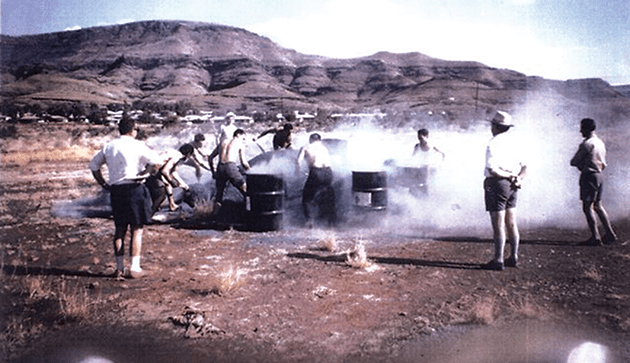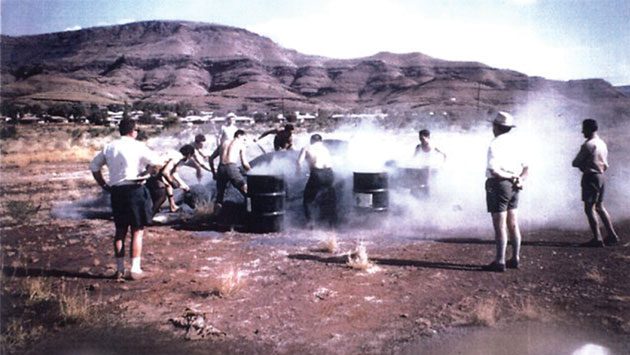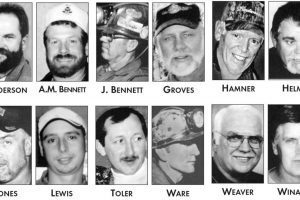With 60,000 people likely to die by 2030 from mining asbestos at Wittenoom, Ludwig Heinrich says many people should be tried for murder and their assets taken as proceeds of crime.
My Mother, Stella Heinrich, was inspired and aspirational. An award winning hotel cook, she made enough extra money from selling her water-colour landscapes to send my brother Les and myself to good schools. She believed that with a good education we could raise ourselves above the hard work and long hours that it took her to provide for our needs.
 Stella Heinrich took jobs in remote areas of WA; in part, because enterprises in those places paid more – but also, in many cases, because she wanted to paint the landscapes of the area. The spectacular landscape was a significant factor when, in the late 1950s, Stella took a job at the staff mess in Wittenoom Gorge for Australian Blue Asbestos (ABA), at that time a fully owned subsidiary of CSR.
Stella Heinrich took jobs in remote areas of WA; in part, because enterprises in those places paid more – but also, in many cases, because she wanted to paint the landscapes of the area. The spectacular landscape was a significant factor when, in the late 1950s, Stella took a job at the staff mess in Wittenoom Gorge for Australian Blue Asbestos (ABA), at that time a fully owned subsidiary of CSR.
It was a well-paid position and, as a bonus, she was encouraged to have her children come and stay with her. The company was also happy to employ my brother Les as soon as he was legally able to work. So, at 15, he had a school holiday job working in the asbestos mill. Financially, we were better off than we had ever been. Les went on to achieve seven distinctions and two exhibitions for his Leaving Certificate, acquired a degree and ran a successful consultancy – until he died a few years ago from mesothelioma.
READ RELATED CONTENT
- Written in Blood | The Moura Mine Disaster
- They took the risk and paid the price | Mount Kembla reflections
- Australian mining | A short history
- Better Training | better outcomes
- Latest news and articles on miner’s health
That’s the turn of the screw. Our family subscribed to the “better yourselves” exhortation; we did our part and, in return, we got early deaths and uneasy minds. Trouble was, there was no responsible person watching. Not from the government, nor from the corporations that stood to gain – or in this case, lose.
Lang Hancock “discovered” Wittenoom Gorge in the early 1930s, and in 1937 started mining blue asbestos from Yampire Gorge. In 1943, he sold a majority share to CSR Limited (ABA became a subsidiary) but remained as manager until 1948 when, according to a CSR Executive:
“…the whole operation was so filthy that we got rid of him and managed the mine ourselves.”
 In 1946, the Yampire Gorge mine was closed and the Wittenoom Gorge mine was opened. For most of the years CSR mined asbestos, the operation lost money and, when the mine closed in 1966, it had an accumulated debt of around $2.5 million (1966 dollars).
In 1946, the Yampire Gorge mine was closed and the Wittenoom Gorge mine was opened. For most of the years CSR mined asbestos, the operation lost money and, when the mine closed in 1966, it had an accumulated debt of around $2.5 million (1966 dollars).
The mine consisted of a number of stopes (tunnels) and a milling operation. The miners had to crawl in the hot dark stopes bent almost double, as many stopes were no more than a metre high, and choking with dust. It was 20 years into the operation before CSR Management even bothered to bore an airhole from the surface to the mine to supply the miners with fresh air.
 Working conditions in the mill were even worse than the mine. The ore from the mine was taken to the mill, via an open conveyor belt, where it was ground down and the fibre extracted. The men worked in clouds of asbestos dust for hours on end, needing flood lights to see even at midday. There is no minimum safe exposure level, a minute at such concentrations is enough to cause lung cancer or mesothelioma.
Working conditions in the mill were even worse than the mine. The ore from the mine was taken to the mill, via an open conveyor belt, where it was ground down and the fibre extracted. The men worked in clouds of asbestos dust for hours on end, needing flood lights to see even at midday. There is no minimum safe exposure level, a minute at such concentrations is enough to cause lung cancer or mesothelioma.
There is absolutely no question that CSR knew that asbestosis and cancer were extremely likely results of working in conditions such as those they permitted in Wittenoom. Their knowledge was established in the Victorian and Western Australian courts through the judgements of asbestos-caused injury litigation. By 1988, a Supreme Court jury found that CSR had been “recklessly indifferent” to the safety of its workers and that ABA knowingly allowed the processing of asbestos to continue even though the dangers of asbestos fibre inhalation were known as early as 1926.
 The court was being conservative, the clangers were expressed in 1898. (Refer to the ‘Annual Report of the Chief Inspector of Factories and Workshops’, Part II. H.M. Stationery Office, 1898, pp. 171-172.) By 1918, overseas insurance companies had already begun to refuse life insurance policies for workers occupationally exposed to asbestos. However, this did not deter industry from mining and manufacturing numerous products containing various types of asbestos for domestic and industrial uses.
The court was being conservative, the clangers were expressed in 1898. (Refer to the ‘Annual Report of the Chief Inspector of Factories and Workshops’, Part II. H.M. Stationery Office, 1898, pp. 171-172.) By 1918, overseas insurance companies had already begun to refuse life insurance policies for workers occupationally exposed to asbestos. However, this did not deter industry from mining and manufacturing numerous products containing various types of asbestos for domestic and industrial uses.
In 1962, the matter was formally brought to the attention of the State Premier and Cabinet of the clay (they already knew), but no action was taken because apparently CSR threatened to close the mine if additional restrictions were to be placed upon their mining and milling, and the Premier, Sir David Brand, was always a firm friend of the mining companies. So much for CSR and the Western Australian State Government’s duties of care.
 Some workers had been sent to Wittenoom as a result of the Commonwealth Government policy to place new migrants in work situations for a period of two years. There were Italians, Greeks, Finns, French – it was a “United Nations” of immigrant workers, few of whom read or spoke English with any fluency.
Some workers had been sent to Wittenoom as a result of the Commonwealth Government policy to place new migrants in work situations for a period of two years. There were Italians, Greeks, Finns, French – it was a “United Nations” of immigrant workers, few of whom read or spoke English with any fluency.
More than 20,000 people lived in Wittenoom, including more than 4,000 children – about 2500 under the age of 15. Add to this the family and friends who visited and then try to guess at the number of Aboriginal people – who did not count after all, not even being included in the census. The concern for the Aboriginal people at the time is perhaps reflected in Lang Hancock’s statement in a 1984 television interview, where he suggested forcing unemployed Indigenous Australians -particularly “no-good half-castes” – to collect their welfare cheques from a central location: “And when they had gravitated there, I would dope the water up so that they were sterile and would breed themselves out in the future.”
More than 2,000 former workers and residents from Wittenoom are known to have died from asbestos diseases and the toll is climbing.(As a comparison during the course of the construction of the Snowy River Scheme 100,000 workers were employed, of whom 121 lost their lives in industrial accidents.) Professor Nico van Zanclwijk, the director of the Asbestos Diseases Research Institute, expects data to show there are between 700 and 750 new cases a year. Part of the reason the number of cases continues to rise is the long gap between exposure and the development of the disease, which can be between 20 and 70 years.
“The men worked in clouds of asbestos dust for hours on end, needing flood lights to see even at midday.”
‘Among women who spent a childhood at Wittenoom, the risk of mesothelioma was 70 to 113 times greater than among the general population. They also had a roughly four-fold increase in risk of brain cancer and three-fold increase in the risk of ovarian cancer. The increase in risk of mesothelioma was slightly lower in men than in women, but men also showed an increased risk of brain, colorectal and prostate cancer, and leukaemia. Wittenoom girls have had a 20-47% greater risk of dying from any cause, while boys have had a 50-83% increased chance of dying from any cause.’
The town swimming pool was a rock hole in the river that flowed though the gorge. ABA “generously” allowed asbestos tailing, the waste from the mill, to be used to create a beach at the pool. “Sand pits” for smaller children were created with tailings. The greens of the golf course were made from tailings. The streets were surfaced with tailings as were footpaths, parking areas, the local racecourse and school playgrounds. So perhaps it is not surprising that Western Australia has the highest rate of malignant mesothelioma of any State in Australia – or, indeed, anywhere else in the world – per capita of population.
But wait, there’s more.
As Bill Shorten explained:
‘Asbestos in 2010, killed – mesothelioma killed 642 people and there are many more with lung cancers related to exposure to asbestos. Numbers of deaths from asbestos are not due to peak until 2020. There’ll be more Australians die from asbestos-related diseases, than died in the whole of the First World War.’
But, while Gallipoli has inspired a tradition of annual remembrance in Australia, asbestos victims continue to be lost in relative silence. Then again, they were only sacrificed to corporate greed and government indifference.
Now all this is a tragedy made very personal to all of us who have lost loved ones, but it is not sympathy that is required, although it is appreciated, but rather there are some serious social and political issues that need to be addressed.
Did the government know about the clangers of asbestos? Certainly, in 1922, a Commonwealth of Australia Department of Health publication listed asbestos work as a hazardous occupation. (See WA Hansard [ASSEMBLY – Thursday, 5 December 2002] p4116b-4138a.)
By the 1930s, well before the Wittenoom mining operation began, there was a substantial amount of scientific knowledge accumulated concerning asbestos-related diseases. Yet the federal immigration policy, that obliged migrants to work wherever they were sent, obviously did not concern itself with the clangers that these workers were exposed to. Nor did the federal health ministers exercise their duties of care.
A BRIEF HISTORY OF ASBESTOS
Asbestos has been used for more than 4,500 years. [Ross, Malcolm & Nolan, Robert P (2003). ‘History of asbestos discovery and use and asbestos-related disease in context with the occurrence of asbestos within the ophiolite complexes’.] For much of the ensuing time, it appears to have mostly been used for a parlour trick. Napkins, cloaks or tablecloths could be cleaned by putting them into the flames of a fire. Roman restaurants used tablecloths made of asbestos, which could be thrown into the fire to remove food and other debris, then placed back on the table for the next customer. But its more practical uses emerged with the Industrial Revolution, and it became increasingly popular in the late 19th century because of its sound absorption and tensile strength and its resistance to fire, heat, electrical and chemical damage. By the micl-20th century, uses included fire retardant coatings, heat spreaders, brake pads, electrical insulation, concrete, bricks, pipes, fireplace cement, pipe insulation, ceiling insulation, fireproof drywall, flooring, roofing, and lawn furniture, as well as heat, fire, and acid resistant gaskets. Asbestos was used in the manufacture of more than 3000 products.
So, the properties of asbestos made it seem almost magical. Resistant to fire, electricity and acid, it was an industrial wonder. However that does not explain why the federal and state governments chose to ignore the medical evidence.
Widespread recognition of the occupational risks of asbestos in Britain was reported in 1924 by a Dr. Cooke, a pathologist, who introduced a case description with the following statement:
‘Medical men in areas where asbestos is manufactured have long suspected the dust to be the cause of chronic bronchitis and fibrosis…’
In the late 1920s, the Merewether Report found that about a quarter of some 360 asbestos-textile workers examined suffered from pulmonary fibrosis. This investigation resulted in improved regulation of the manufacturing of asbestos-containing products in the early 1930s. Regulations included industrial hygiene standards, medical examinations, and inclusion of the asbestos industry into the British Workers’ Compensation Act. But none of this was acted upon in Australia.
Local Australian responses were also ignored. Dr Jim McNulty AO visited Wittenoom milling and mining operations between 1957 and 1962 in his capacity as mine medical officer. He was adamant that CSR was always aware that if it continued to run the mine without adequate dust suppression, they could be endangering the Wittenoom mine and mill workers to a very grave degree. This information was passed on to the WA Government and, in all likelihood, the Federal Government was also made aware of his findings.
Dr Bruce Hunt wrote on September 25 1961: ‘After examining the evidence which has been produced for you I find it very difficult to believe that a reputable public company (CSR) could remain in its apparently self-satisfied state and continue to allow the asbestos mining industry to go on killing men unfortunate enough to be employed in it.”
He addressed this to CSR, but the State Government of Sir David Brand and the minister responsible for mining Sir Charles Court were soon made aware of his findings.
And yes, there is even more.
Some of the migrant workers forced to work in these conditions by the federal Department of Immigration, returned to their countries of origin and it is not known how many of them died from conditions arising from their exposure to asbestos. Also, Government reports state:
‘…most public buildings and about one third of private dwellings built in this era contained asbestos in the forms of concrete, asbestos cement sheeting (AC sheeting or fibro), vinyl floor coverings, lagging of pipes and boilers, and insulation (laid or sprayed).’
A QUESTION OF ETHICS
Asbestos is a naturally occurring substance that seemed to provide valuable economic benefits in industry, manufacturing and construction, but even before that could occur (in Australia) it was already known that asbestos also entailed a high public risk.
What this story illustrates is that there are serious ethical issues when a society allows itself to be driven by its market economy. Societies need a moral framework to exist. If we do not address the health and well-being of our citizens – and by extension the planet – but only make decisions on the basis of the financial benefits that some might derive from an enterprise, we will make wrong moral choices.
The idea that businesses and government will always act in accordance with the needs of the general population (or the planet) is not plausible and, unless we apply strict protocols in ethics, there is little chance of it happening. But it is possible, and governments do sometimes act in accordance with needs – as, for example, in the establishment of the Office of Asbestos Safety. But all too often, as indeed in that case, this occurs after the fact. All it can do is ameliorate the situation and diminish the on-going harm.
But, although the terms of reference for the Asbestos Management Review only allowed it to make recommendations for the development of a national strategic plan to improve asbestos awareness and management, it is interesting to note that it states:
‘Arguably one of the primary responsibilities of government is to protect its citizens from known and potential hazards; especially where those hazards result from the previous implementation of government programs and policy.’
No institutions or systems of governance can provide the guarantees of fairness that moral philosophers aspire to. Few, if any, systems offer any guarantees at all, but allowing people to profit from the suffering of others is surely not acceptable. We have seen where this leads. Businesses seek money and governments seek power; to achieve their ends they must convince those outside their cabal that what they do is in our interest. But so often they conspire to convince us by withholding or reframing the facts.
There is a mechanism to redress the wrongs of the asbestos trade – and to fund the ongoing amelioration process – and that is the Proceeds of Crime Act 2002. The Act has provisions to recover assets generated from, or used in, a crime, along with benefits derived from an offence or other illegal activity. And a contrived event that leads to the death of 60,000 Australians by 2030 is surely – most definitely – a crime.
“There’ll be more Australians die from asbestos-related diseases, than died in the whole of the First World War.’
This is an extract of an article that first appeared in Independent Australia. It has been re-published in this edition of Australasian Mine Safety Journal with kind permission.
Visit www.independentaustralia.net for more of in-depth articles about the topics that matter.















Excellent and tragic article that needed to be written and publicised widely. Heart goes out to all affected by the irresponsibility of others.
This is a powerful response to shameful chapter in Australia’s repertoire of silenced histories and asbestos is still a major health hazard. We are now seeing a burst of activism and publishing from surviving family members of The Great Asbestos Saga, largely due to the online publishing arena and social media. The political response from the Heinrich family an exemplar conscious of people power. This builds on the tremendous work of of anti-asbestos activists nationally and globally. As we remediate the asbestos narrative we keep this once hidden catastrophe at the forefront of others who remain unaware of hidden dangers in their homes and work places. One thing that Australia needs to do is prosecute those officials and corporate elites for crimes against humanity.
In 2012 the Italian Courts sentenced Stephan Schmidheiny, a former owner of the asbestos giant Eternit, and Jean-Louis Marie Ghislain de Cartier de Marchienne, a major shareholder for exposing workers to asbestos and causing an environmental disaster. Seems like we have an easy precedent to follow with James Hardie and CSR and the like…
Lang Hancock really was a piece of work wasn’t he. It’s a shame his fortune can’t be seized retrospectively & redistributed to all the people harmed by him.